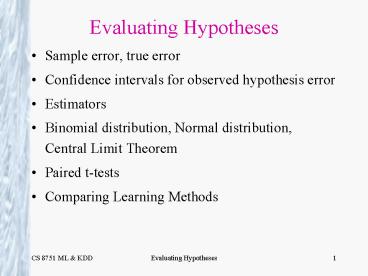Sample error, true error PowerPoint PPT Presentation
Title: Sample error, true error
1
Evaluating Hypotheses
- Sample error, true error
- Confidence intervals for observed hypothesis
error - Estimators
- Binomial distribution, Normal distribution,
Central Limit Theorem - Paired t-tests
- Comparing Learning Methods
2
Problems Estimating Error
- 1. Bias If S is training set, errorS(h) is
optimistically biased - For unbiased estimate, h and S must be chosen
independently - 2. Variance Even with unbiased S, errorS(h) may
still vary from errorD(h)
3
Two Definitions of Error
- The true error of hypothesis h with respect to
target function f and distribution D is the
probability that h will misclassify an instance
drawn at random according to D. - The sample error of h with respect to target
function f and data sample S is the proportion of
examples h misclassifies - How well does errorS(h) estimate errorD(h)?
4
Example
- Hypothesis h misclassifies 12 of 40 examples in
S. - What is errorD(h)?
5
Estimators
- Experiment
- 1. Choose sample S of size n according to
distribution D - 2. Measure errorS(h)
- errorS(h) is a random variable (i.e., result of
an experiment) - errorS(h) is an unbiased estimator for errorD(h)
- Given observed errorS(h) what can we conclude
about errorD(h)?
6
Confidence Intervals
- If
- S contains n examples, drawn independently of h
and each other - Then
- With approximately N probability, errorD(h) lies
in interval
7
Confidence Intervals
- If
- S contains n examples, drawn independently of h
and each other - Then
- With approximately 95 probability, errorD(h)
lies in interval
8
errorS(h) is a Random Variable
- Rerun experiment with different randomly drawn S
(size n) - Probability of observing r misclassified examples
9
Binomial Probability Distribution
10
Normal Probability Distribution
11
Normal Distribution Approximates Binomial
12
Normal Probability Distribution
13
Confidence Intervals, More Correctly
- If
- S contains n examples, drawn independently of h
and each other - Then
- With approximately 95 probability, errorS(h)
lies in interval - equivalently, errorD(h) lies in interval
- which is approximately
14
Calculating Confidence Intervals
- 1. Pick parameter p to estimate
- errorD(h)
- 2. Choose an estimator
- errorS(h)
- 3. Determine probability distribution that
governs estimator - errorS(h) governed by Binomial distribution,
approximated by Normal when - 4. Find interval (L,U) such that N of
probability mass falls in the interval - Use table of zN values
15
Central Limit Theorem
16
Difference Between Hypotheses
17
Paired t test to Compare hA,hB
18
N-Fold Cross Validation
- Popular testing methodology
- Divide data into N even-sized random folds
- For n 1 to N
- Train set all folds except n
- Test set fold n
- Create learner with train set
- Count number of errors on test set
- Accumulate number of errors across N test sets
and divide by N (result is error rate) - For comparing algorithms, use the same set of
folds to create learners (results are paired)
19
N-Fold Cross Validation
- Advantages/disadvantages
- Estimate of error within a single data set
- Every point used once as a test point
- At the extreme (when N size of data set),
called leave-one-out testing - Results affected by random choices of folds
(sometimes answered by choosing multiple random
folds Dietterich in a paper expressed
significant reservations)
20
Results Analysis Confusion Matrix
- For many problems (especially multiclass
problems), often useful to examine the sources of
error - Confusion matrix
21
Results Analysis Confusion Matrix
- Building a confusion matrix
- Zero all entries
- For each data point add one in row corresponding
to actual class of problem under column
corresponding to predicted class - Perfect prediction has all values down the
diagonal - Off diagonal entries can often tell us about what
is being mis-predicted
22
Receiver Operator Characteristic (ROC) Curves
- Originally from signal detection
- Becoming very popular for ML
- Used in
- Two class problems
- Where predictions are ordered in some way (e.g.,
neural network activation is often taken as an
indication of how strong or weak a prediction is) - Plotting an ROC curve
- Sort predictions (right) by their predicted
strength - Start at the bottom left
- For each positive example, go up 1/P units where
P is the number of positive examples - For each negative example, go right 1/N units
where N is the number of negative examples
23
ROC Curve
100
75
True Positives ()
50
25
25
50
75
100
0
False Positives ()
24
ROC Properties
- Can visualize the tradeoff between coverage and
accuracy (as we lower the threshold for
prediction how many more true positives will we
get in exchange for more false positives) - Gives a better feel when comparing algorithms
- Algorithms may do well in different portions of
the curve - A perfect curve would start in the bottom left,
go to the top left, then over to the top right - A random prediction curve would be a line from
the bottom left to the top right - When comparing curves
- Can look to see if one curve dominates the other
(is always better) - Can compare the area under the curve (very
popular some people even do t-tests on these
numbers)

